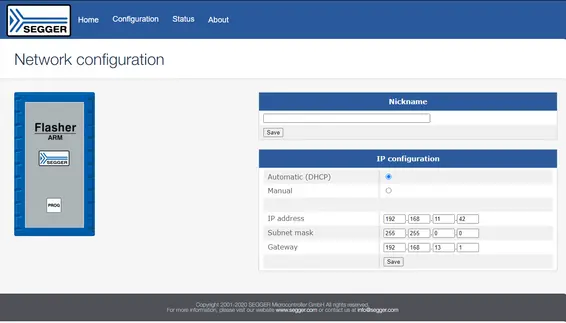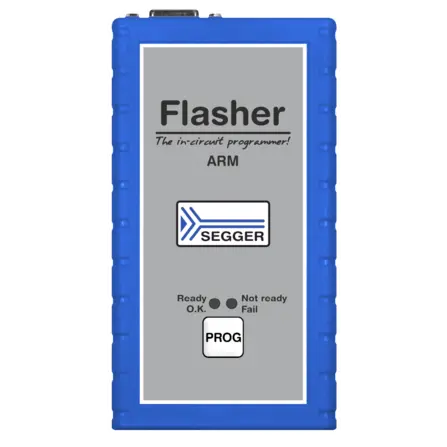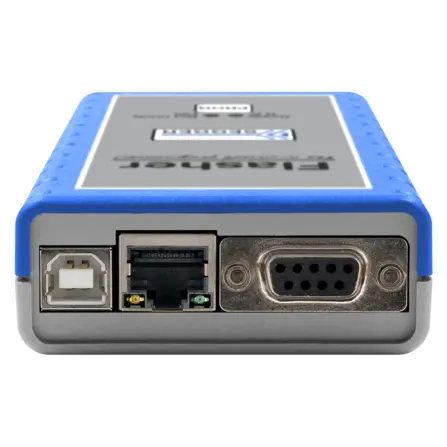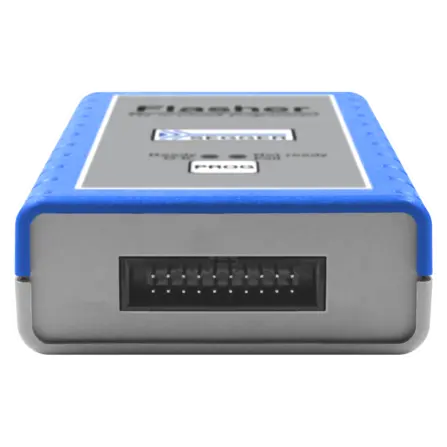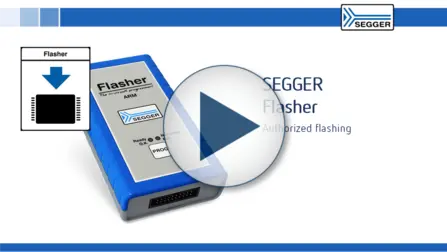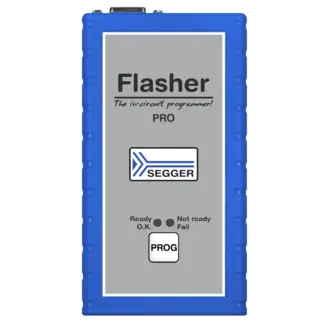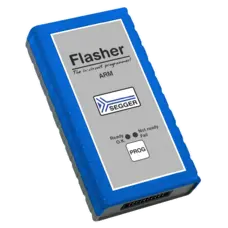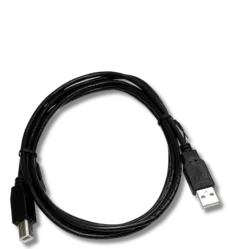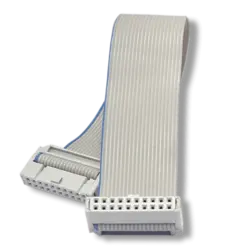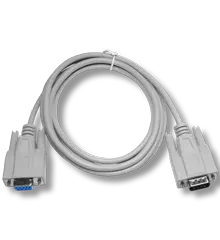Flasher ARM
The flash programmer for Arm-based microcontrollers
Flasher ARM is SEGGER's flash programming tool designed for Arm microcontrollers.

Overview
The Flasher ARM is used to program the non-volatile memories of Arm-based microcontrollers and Systems-on-a-Chip (SoCs) as well as external flashes like (Q)SPI flashes that are directly connected to the microcontroller. It can be used in stand-alone or PC-based mode and connects via USB, Ethernet or an RS232 interface. Like the Flasher PRO, it has a 20-pin connector, which is compatible with the standard 20-pin JTAG connector defined by Arm. Various adapters are available.
As a multi-platform solution, Flasher ARM comes with the setup and control software for Linux, macOS and Windows. Software and firmware updates are included. Similarly, use on all target devices currently supported, and on any that will be added, is also included.
Key features
- Has 128 MB internal memory
- Supports internal & external flash devices
- Built-in web & FTP server for easy setup
- Includes Flasher software package
- No license required. No hidden costs. No future costs.
- Future proof: Software, firmware updates, and new flash loaders are free of charge.
Supported devices
The Flasher ARM as a member of the SEGGER Flasher family supports a wide range of CPU cores and an even wider range of different devices in PC-based mode. The list of supported manufacturers, families, and devices and SoCs includes support for tens of thousands of devices in hundreds of device families with billions of devices programmed.
Device not listed? Please don’t hesitate to contact us.

Universal target support
Flasher ARM has a very flexible target and programming interface.
Based on an FPGA with an integrated CPU core, it has multiple dedicated soft cores controlling the target interface, and a virtual processor running the flash loader.
This concept makes it possible to adapt to almost any system for ISP programming purposes. Dedicated flash loaders, which can be easily downloaded to the programmer, make it possible to program almost any device. This flexibility allows using the debug or dedicated programming interfaces of microcontrollers to program the on-chip memories as well as the programming of the off-chip parallel or (Q)SPI flashes. (Q)SPI can also be programmed directly.
Software
All software is included free of charge. It comes with the flash loaders for all supported devices.
For every Flasher, the Flasher Software and Documentation Package is available:
Updates
Future software and firmware updates as well as any new flash loaders for target devices that will be added, are also free of charge.
- No licensing costs, even for newly supported devices.
- No hidden costs.
- No future costs.
Multi-platform
As a multi-platform solution, Flasher ARM comes with the setup and control software for Linux, macOS and Windows. Software and firmware updates are included. Similarly, use on all currently supported target devices, and any that will be added, is also included.
Serial number assignment
Many modern devices require some pieces of unique information. Flasher ARM allows the programming of data that differs amongst other otherwise identical units. Typical examples are things like serial numbers, ethernet hardware addresses (MAC), and digital signatures, and license keys that enable/disable product features. All these options can be adapted from device to device by applying patch data to the original firmware.
Flexible control and monitoring
The Flasher ARM is easy to set up and operate using SEGGER software tools. It can be operated in either stand-alone or PC-based programming mode. In stand-alone mode it can be operated via remote control (USB, UART, Ethernet) or by the push of a button or TTL triggers.

Built-in web server
The Flasher ARM offers options to check status information remotely and to configure the device.
Remote monitoring
The Flasher ARM comes with SEGGER's built-in web server. It is designed to present important device and current operation data for a quick overview and, additionally, to check the status of the programmer, providing information about:
- Installed firmware version
- Hardware version
- Power consumption
- IP configuration
- Network load
- Current operation and status
- Programming interface in use
This may be important for fast troubleshooting through code verification, for instance, as it is when executing a cyclic redundancy check (CRC) that helps to detect errors during data transmission or storage.
Configuration
If needed, the built-in web server's programmer settings can be checked and adjusted. These could, for example, be parameters like:
- Nickname
- Subnet mask
- Gateway
Built-in FTP server
The Flasher ARM also includes the emFTP server to upload firmware and configuration or download log files.
Remote file update
Using the emFTP server enables easy upload of configuration files and firmware images. By connecting to the emFTP server using an FTP client of choice, files can be transferred between client and Flasher.
Having access to the Flasher configuration via FTP enables configuration of multiple Flashers from a central production control server. This interface also can be used to make the production line part of a CI/CD system to push stable releases into the current production.
Log file
Analyzing the reliability of the production line is an important task, when it comes to increasing the production frequency. This purpose is supported by the built-in FTP server, which lets users check the history of past programming cycles via log file download. Each entry provides the following information:
- Result (success/failure)
- Duration
- Serial number (if programmed)
For failed programming cycles, the log file provides additional information for quick troubleshooting (e.g. failed to open Flasher config file).
Media gallery
Videos
Aug. 2016 | 2:14 min
Flasher ARM — Authorized Flashing
Flasher PRO — The "almost-anything" flash programmer
The Flasher PRO is SEGGER’s full-featured, in-circuit flash programmer for microcontrollers and SoCs as well as (Q)SPI flashes. It is designed from the ground up to be a fast and universal flash programmer.
Technical specifications
| Specifications | |||||
|---|---|---|---|---|---|
| Power supply | USB-powered, 500 mA if target is powered by Flasher ARM | ||||
| USB host interface | USB2.0 (High-Speed), USB Type B | ||||
| RS232 host interface | RS232 9-pin | ||||
| Target interface | JTAG 20-pin (14-pin adapter available) | ||||
| Max. target cable length | Recommended (delivered): 20 cm (8") Max. 2 m (6.5") allowed but might reduce max. target interface speed. | ||||
| Serial transfer rate between Flasher ARM and Target | up to 50 MHz | ||||
| Supported target voltage | 1.2 - 5 V | ||||
| Current drawn from target voltage sense pin (VTRef) | < 25 µA | ||||
| Target supply voltage | 5 V | ||||
| Target supply current | Max. 400 mA | ||||
| Reset type | Open drain with 100 Ohms series resistor. Can be pulled low or tristated | ||||
| Operating temperature | + 5 °C ... + 60 °C | ||||
| Storage temperature | - 20 °C ... + 65 °C | ||||
| Relative humidity (non-condensing) | 90 % rH | ||||
| Size (without cables) | 121 mm x 66 mm x 30 mm | ||||
| Weight (without cables) | 120 g | ||||
| Supported OS | Microsoft Windows (x86/x64), Linux (x86/x64/Arm), macOS (x86/Apple Silicon) | ||||
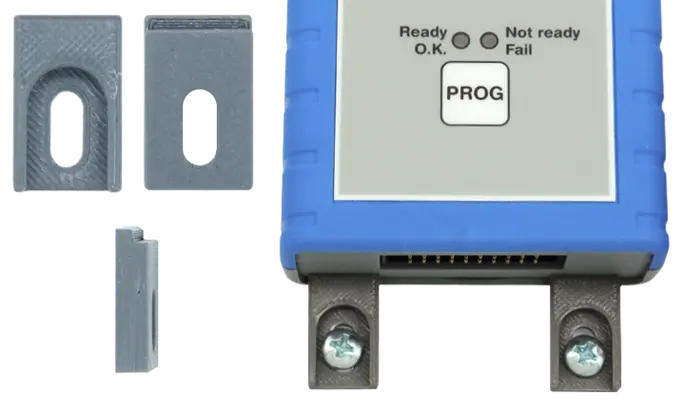
Mounting brackets
SEGGER's mounting brackets provide a reliable solution for securely fastening Flasher in-circuit programmers during use. Designed for stability and ease of use, these brackets ensure a tidy and professional setup.
The mounting brackets are available directly from the SEGGER shop.
Alternatively, we offer the option to 3D print the mounting brackets yourself. A downloadable ZIP file is provided, containing a STEP file for modifications, an STL file ready for 3D printing, and a PDF with detailed dimensions.
FAQ
Q: What is the maximum voltage that can be handled by the galvanic isolation of the Ethernet?
A: The Ethernet data lines are isolated as required per IEEE 802.3 (test voltage 1500 Vrms for one minute). Note that this is NOT valid for the Ethernet shield that has a direct electrical contact to the USB shield and a resistive and capacitive coupling to probe GND. For an effective isolation, you need to use an unshielded twisted pair Ethernet cable.

